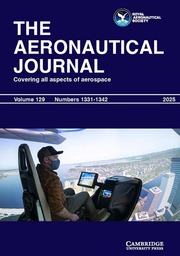Article contents
Predicted performance characteristics of avariable cycle turbofan
Published online by Cambridge University Press: 04 July 2016
Abstract
The selective bleed turbofan is a two shaft, three compressor, variable cycle aircraft engine. Its bypass ratio (BPR) can be modulated to suit the operating flight conditions. At subsonic flight speeds it operates as a medium bypass turbofan (low pressure mode or LPM). It becomes a low bypass turbofan (high pressure mode or HPM) when flying faster and is capable of supersonic cruise without reheat (RH).
The aim of this paper is to describe the selection of the main engine design parameters in the HP mode and to outline the challenges to be met to enable the powerplant to operate in the other mode. The components have to perform satisfactorily over a wide range of varying conditions. The resulting demands are reflected in many ways, for example in the operating lines of the low pressure compressors and in the overall efficiency changes with increased bypass ratio. In the case of the present investigation the two bypass ratios selected are 0·3 for the high pressure mode and 0·7 for the low pressure mode. The latter was selected after an examination of a choice of bypass ratios ranging from 0·4 to 1·0. The change in variable stators required to achieve the LP mode cycle is indicated.
The effect of changing bypass ratio on engine performance and handling is shown. The main conclusion is that the design of this engine seems to be feasible within current technological capabilities and further investigation is encouraged because it appears to yield significant benefits.
Information
- Type
- Research Article
- Information
- Copyright
- Copyright © Royal Aeronautical Society 1997
References
- 9
- Cited by

